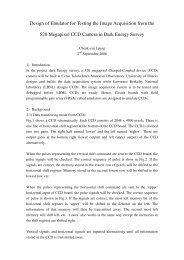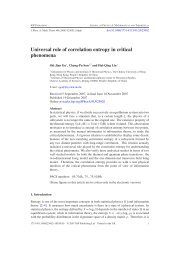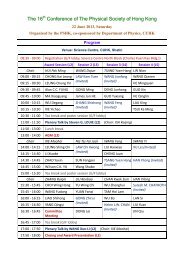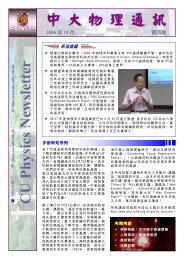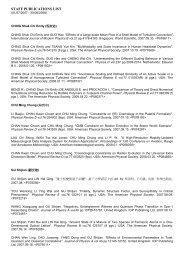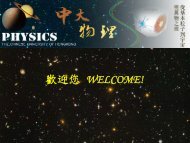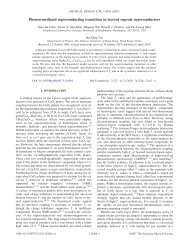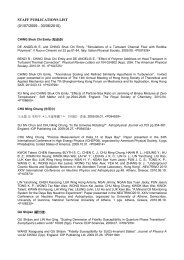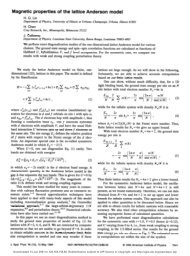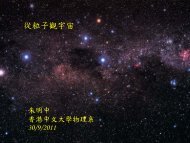19th Issue (Oct-2012) - Department of Physics - The Chinese ...
19th Issue (Oct-2012) - Department of Physics - The Chinese ...
19th Issue (Oct-2012) - Department of Physics - The Chinese ...
Create successful ePaper yourself
Turn your PDF publications into a flip-book with our unique Google optimized e-Paper software.
My Experience as Student and Researcher<br />
Int. J. Mod. Phys. A <strong>2012</strong>.27. Downloaded from www.worldscientific.com<br />
by THE CHINESE UNIVERSITY OF HONG KONG on 10/09/12. For personal use only.<br />
As a matter <strong>of</strong> fact, my 1954 work with Mills was another example <strong>of</strong> the usefulness<br />
<strong>of</strong> generalization: We generalized the gauge invariance <strong>of</strong> electromagnetism<br />
to non-Abelian gauge invariance.<br />
I moved from the IAS in Princeton to Stony Brook University in 1966. At Stony<br />
Brook I began to regularly teach undergraduate and graduate courses, which I did<br />
not do in the IAS. One day in 1967 or 1968 I was teaching a course on general<br />
relativity. As I wrote down on the blackboard the famous curvature equation <strong>of</strong><br />
Riemann:<br />
R l ijk =<br />
∂ { } l<br />
∂x j −<br />
ik<br />
∂ { } { }{ } { }{ }<br />
l m l m l<br />
∂x k +<br />
−<br />
, (E)<br />
ij ik mj ij mk<br />
I noticed its similarity to the equation <strong>of</strong> gauge theory exhibited above as (D). After<br />
the lecture I examined these two equations in detail and realized they were in fact<br />
both special cases <strong>of</strong> a general type <strong>of</strong> equation. In great excitement I went to Jim<br />
Simons, who was then the Chair <strong>of</strong> Mathematics <strong>Department</strong> in Stony Brook. He<br />
told me they were both equations in fiber bundle theory and gave me a copy <strong>of</strong> a<br />
standard monograph on the subject by Steenrod. <strong>The</strong> book turned out to be too<br />
dry and too formal for me and I did not learn anything from it. A few years later I<br />
asked Simons to give us physicists informal lectures on the basic ideas <strong>of</strong> fiber bundle<br />
theory. <strong>The</strong>se lectures were extremely helpful to us, enabling us to realize that the<br />
basic physical concepts <strong>of</strong> all gauge theory (including electromagnetism), such as<br />
potentials, field strengths, etc., are in fact identical to beautiful basic geometrical<br />
concepts in fiber bundle theory. I was deeply awed and inspired by this realization.<br />
Two lessons I learned from this experience:<br />
Fundamental physics is based on beautiful mathematics. (10)<br />
But not all beautiful mathematics find their way into physics. (11)<br />
In Stony Brook I began to have Ph.D. students. My style <strong>of</strong> guiding students was<br />
such that I rarely had more than one graduate student at any time. So altogether<br />
I graduated only about ten Ph.D. students. But I am proud to have influenced<br />
the career <strong>of</strong> several graduate students some <strong>of</strong> whom were in fact not my own:<br />
<strong>The</strong>y had come to Stony Brook aiming at specializing in high energy physics. I<br />
told them high energy physics did make spectacular progress in the years before<br />
1980, but after that it was difficult for a young person to make good contributions<br />
in that field. <strong>The</strong> big accelerations were becoming increasingly expensive, and the<br />
collaborative experiments were becoming too too big. Unfortunately many young<br />
people did not realize these and continue to enter the field, causing overcrowding,<br />
and the number <strong>of</strong> good ideas/person/year in the field became very small.<br />
Several Stony Brook graduate students did take my advice seriously and I am<br />
happy today that they are now very successful in their respective fields different<br />
from high energy physics.<br />
A graduate student had better not choose a field<br />
which is becoming overcrowded.<br />
(12)<br />
1230009-17



